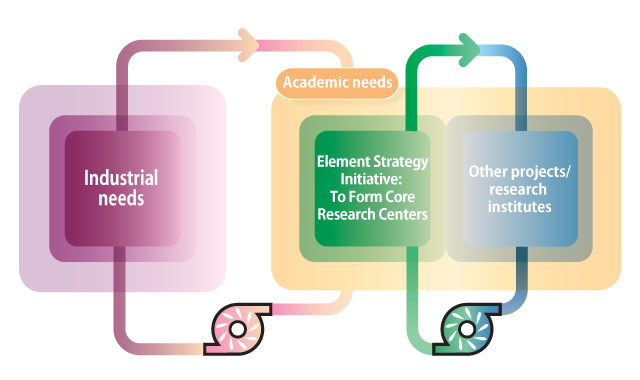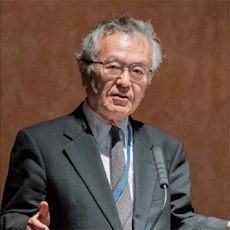3rd Symposium on the Element Strategy Initiative (to Form Core Research Centers) and Large-scale Research Facilities Toward the understanding of the mechanisms of material functionalities inspired by new theories, and their industrial applications
As described in a 2007 report by the MEXT Working Group for Element Strategy, the Element Strategy Initiative was established to conduct research aimed at the development of materials based on the understanding and effective use of the roles of elements that determine the properties and functionalities of materials. Later in 2010 society faced a severe shortage of rare metals. In light of the urgency of this issue, the Nanotechnology and Materials Science Council decided on January 6, 2012 that, in addition to the individual studies being conducted by JST, other activities should be implemented under the Element Strategy Initiative: To Form Core Research Centers for the purpose of sparking innovation and accelerating progress in materials research itself.
The vision laid out by this committee notes the need for the basic materials science community to become more engaged in society by expanding its area of basic research through collaboration among materials science, metallography, physics, chemistry, and advanced equipment analysis. This will not only help foster the next generation, but will also set high goals that will directly lead to innovation by adopting the viewpoints of industry. The initiative has presented academia a path for future development by overcoming present problems, and I would like to express my gratitude to all personnel at MEXT who were involved in making this initiative a reality.
The name of the initiative in English is the Element Strategy Initiative: To Form Core Research Centers. Thus, the initiative was born from the awareness that Japan needs to establish research centers, rather than to assemble a collection of individual research topics. Specifically, each of the four centers on magnetic materials, electronic materials, catalysts and batteries, and structural materials has been working to broaden and deepen its scientific understanding through synergetic efforts among research groups related to materials development, measurement, and analysis and theory based on electronic states, while simultaneously perceiving the needs of society.
Collaboration with our large-scale cutting-edge research facilities, which are the pride of Japan, has played important roles in driving the centers’ activities. This scheme is further reinforced by such basic research institutes as the Institute for Molecular Science (IMS), the Institute for Materials Research (IMR), and the Institute for Solid State Physics (ISSP), which support this collaboration between each center of the initiative and the large-scale research facilities according to their own characteristic research activities.
As the Element Strategy Initiative has advanced, there has been much research collaboration with outside researchers. The results of this collaboration will also be reflected at this symposium, which will not be confined to the Element Strategy Initiative, but will also present related research activities on diverse topics associated with materials science.
There are few precedents in the world for research activities similar to the Element Strategy Initiative. Hereafter, we would like to widen our sphere of activity by communicating our efforts to the world and making the next (4th) Symposium into an international one. We hope we can count on your active collaboration.
Note: The website for this symposium provides a transcript of a roundtable discussion attended by the program committee members entitled “The Future of the Element Strategy Initiative.” Please take the time to read this discussion.
I would like to take this time to thank all of the program committee members who contributed to this important program.
Program Committee Members
Yoshiyuki Amemiya, The University of Tokyo
Takahiko Iriyama, Daido Steel Co., Ltd.
Kohei Uosaki, National Institute for Materials Science (NIMS)
Kosaku Ushioda, Nippon Steel & Sumikin Research Institute Corporation
Maki Kawai, Institute for Molecular Science
Jun Sugiyama, Toyota Central R&D Labs., Inc.
Toru Setoyama, Mitsubishi Chemical Corporation
Masatoshi Takao, formerly of Osaka University, Panasonic Corporation
Koki Takanashi, Institute for Materials Research, Tohoku University
Shinji Tsuneyuki, The University of Tokyo
Kiyoyuki Terakura, National Institute for Materials Science (NIMS)
Makoto Hayashi, Comprehensive Research Organization for Science and Society
Hideo Hosono, Tokyo Institute of Technology
Hidetoshi Fukuyama, Tokyo University of Science

(Figure 1) System of collaboration with the Element Strategy Initiative: To Form Core Research Centers

(Figure 2) Collaborative role of the symposium
The Symposium on the Element Strategy Initiative and Large-scale Research Facilities serves as a vehicle to facilitate collaboration and cooperation among industry and researchers/research institutes involved in materials science through the exploration of scientific findings.

Hidetoshi Fukuyama
Expert Advisor to the Management Committee of the Element Strategy Initiative
Tokyo University of Science